Decision Tree Classification Algorithm
Note: A decision tree can contain categorical data (YES/NO) as well as numeric data.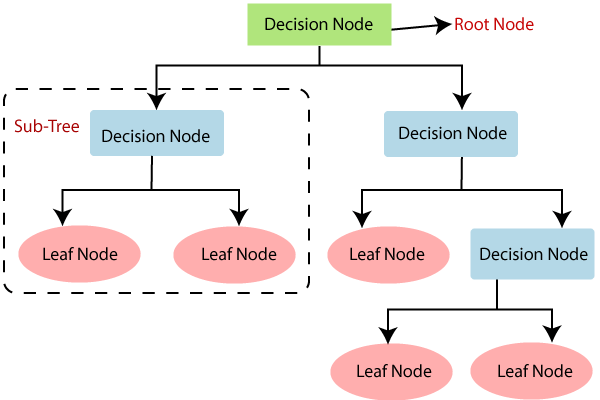
Why use Decision Trees?There are various algorithms in Machine learning, so choosing the best algorithm for the given dataset and problem is the main point to remember while creating a machine learning model. Below are the two reasons for using the Decision tree:
Decision Tree TerminologiesHow does the Decision Tree algorithm Work? In a decision tree, for predicting the class of the given dataset, the algorithm starts from the root node of the tree. This algorithm compares the values of root attribute with the record (real dataset) attribute and, based on the comparison, follows the branch and jumps to the next node. For the next node, the algorithm again compares the attribute value with the other sub-nodes and move further. It continues the process until it reaches the leaf node of the tree. The complete process can be better understood using the below algorithm:
Example: Suppose there is a candidate who has a job offer and wants to decide whether he should accept the offer or Not. So, to solve this problem, the decision tree starts with the root node (Salary attribute by ASM). The root node splits further into the next decision node (distance from the office) and one leaf node based on the corresponding labels. The next decision node further gets split into one decision node (Cab facility) and one leaf node. Finally, the decision node splits into two leaf nodes (Accepted offers and Declined offer). Consider the below diagram: 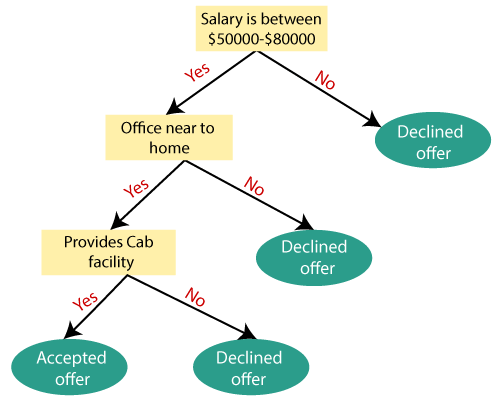
Attribute Selection MeasuresWhile implementing a Decision tree, the main issue arises that how to select the best attribute for the root node and for sub-nodes. So, to solve such problems there is a technique which is called as Attribute selection measure or ASM. By this measurement, we can easily select the best attribute for the nodes of the tree. There are two popular techniques for ASM, which are:
1. Information Gain:
Entropy: Entropy is a metric to measure the impurity in a given attribute. It specifies randomness in data. Entropy can be calculated as: Entropy(s)= -P(yes)log2 P(yes)- P(no) log2 P(no) Where,
2. Gini Index:
Gini Index= 1- ∑jPj2 Pruning: Getting an Optimal Decision treePruning is a process of deleting the unnecessary nodes from a tree in order to get the optimal decision tree. A too-large tree increases the risk of overfitting, and a small tree may not capture all the important features of the dataset. Therefore, a technique that decreases the size of the learning tree without reducing accuracy is known as Pruning. There are mainly two types of tree pruning technology used:
Advantages of the Decision Tree
Disadvantages of the Decision Tree
Python Implementation of Decision TreeNow we will implement the Decision tree using Python. For this, we will use the dataset "user_data.csv," which we have used in previous classification models. By using the same dataset, we can compare the Decision tree classifier with other classification models such as KNN SVM, LogisticRegression, etc. Steps will also remain the same, which are given below:
1. Data Pre-Processing Step:Below is the code for the pre-processing step: In the above code, we have pre-processed the data. Where we have loaded the dataset, which is given as: 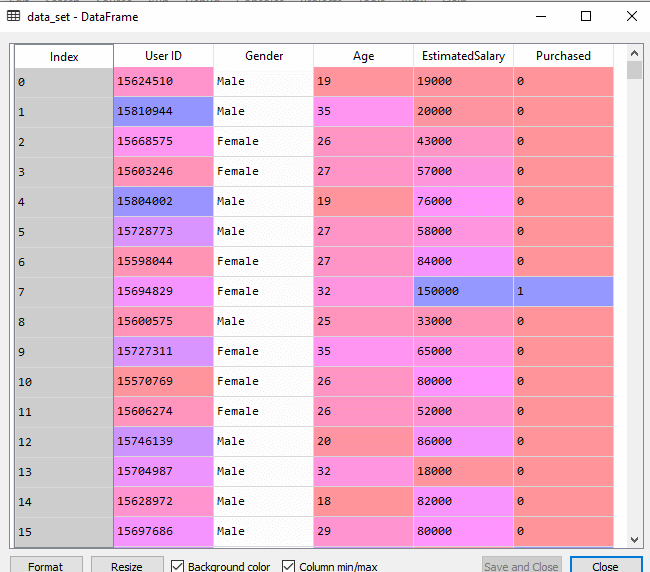
2. Fitting a Decision-Tree algorithm to the Training setNow we will fit the model to the training set. For this, we will import the DecisionTreeClassifier class from sklearn.tree library. Below is the code for it: In the above code, we have created a classifier object, in which we have passed two main parameters;
Below is the output for this:
Out[8]:
DecisionTreeClassifier(class_weight=None, criterion='entropy', max_depth=None,
max_features=None, max_leaf_nodes=None,
min_impurity_decrease=0.0, min_impurity_split=None,
min_samples_leaf=1, min_samples_split=2,
min_weight_fraction_leaf=0.0, presort=False,
random_state=0, splitter='best')
3. Predicting the test resultNow we will predict the test set result. We will create a new prediction vector y_pred. Below is the code for it: Output: In the below output image, the predicted output and real test output are given. We can clearly see that there are some values in the prediction vector, which are different from the real vector values. These are prediction errors. 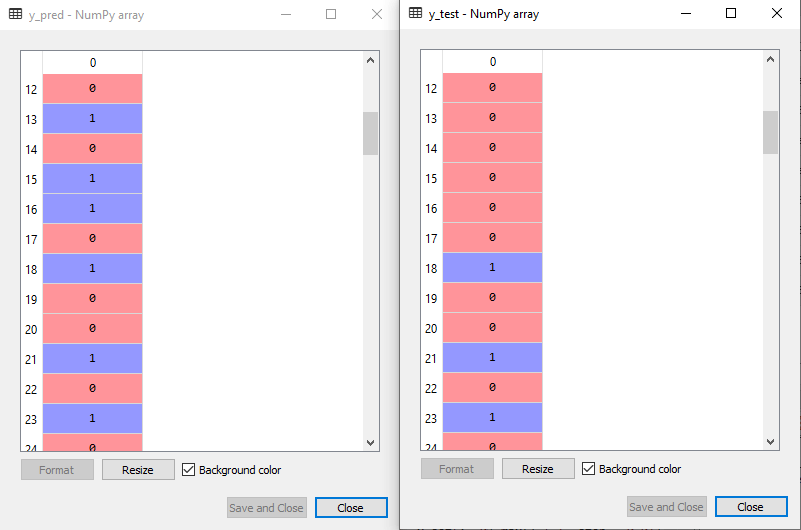
4. Test accuracy of the result (Creation of Confusion matrix)In the above output, we have seen that there were some incorrect predictions, so if we want to know the number of correct and incorrect predictions, we need to use the confusion matrix. Below is the code for it: Output: 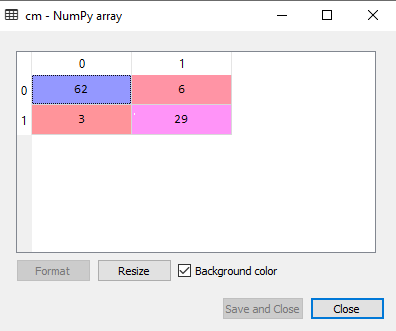
In the above output image, we can see the confusion matrix, which has 6+3= 9 incorrect predictions and62+29=91 correct predictions. Therefore, we can say that compared to other classification models, the Decision Tree classifier made a good prediction. 5. Visualizing the training set result:Here we will visualize the training set result. To visualize the training set result we will plot a graph for the decision tree classifier. The classifier will predict yes or No for the users who have either Purchased or Not purchased the SUV car as we did in Logistic Regression. Below is the code for it: Output: 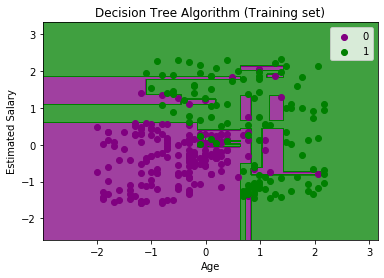
The above output is completely different from the rest classification models. It has both vertical and horizontal lines that are splitting the dataset according to the age and estimated salary variable. As we can see, the tree is trying to capture each dataset, which is the case of overfitting. 6. Visualizing the test set result:Visualization of test set result will be similar to the visualization of the training set except that the training set will be replaced with the test set. Output: 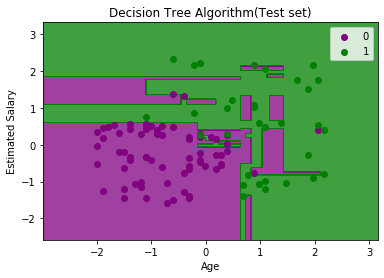
As we can see in the above image that there are some green data points within the purple region and vice versa. So, these are the incorrect predictions which we have discussed in the confusion matrix.
Next TopicMachine Learning Interview Questions
|
 For Videos Join Our Youtube Channel: Join Now
For Videos Join Our Youtube Channel: Join Now
Feedback
- Send your Feedback to [email protected]
Help Others, Please Share










